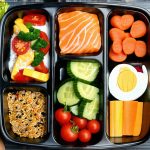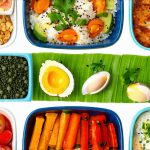Brain fog and gut sensitivity often go hand-in-hand, creating a frustrating cycle where what you eat impacts your cognitive function, and difficulty thinking makes healthy eating even harder. It’s not simply about avoiding trigger foods; it’s about streamlining the entire process of meal planning, shopping, and preparation when executive functioning is compromised. Many individuals experience significant challenges with seemingly simple tasks like deciding what to eat, remembering ingredients, or having the energy to cook. This article will delve into practical meal organization techniques designed specifically for those navigating these difficulties, focusing on strategies that minimize decision fatigue and maximize ease while respecting dietary needs related to gut health. Understanding gut function is often the first step towards improvement.
The key is building systems—not restrictive diets. We’re aiming for sustainable habits that work with your brain and body, not against them. This means acknowledging the limitations imposed by brain fog (forgetting things, difficulty concentrating) and gut sensitivity (bloating, discomfort, unpredictable reactions), and then adapting meal organization to account for these challenges. It’s about reducing cognitive load, simplifying choices, and creating a buffer against reactive eating or falling back on convenient but potentially triggering foods. Remember that consistency is more valuable than perfection; small, manageable changes can lead to significant improvements over time. Many find probiotics helpful in managing some of these sensitivities.
Simplifying Meal Planning & Grocery Shopping
Meal planning often feels overwhelming when brain fog clouds your thinking. Trying to come up with creative recipes and detailed shopping lists can be exhausting. The solution isn’t necessarily elaborate meal plans but rather structured simplicity. Instead of aiming for variety every single day, focus on establishing a rotation of well-tolerated meals that you know won’t exacerbate gut issues. This reduces the mental burden of constant decision-making.
Consider building your plan around “template” meals. These are basic frameworks that can be customized with minor variations. For example: “Protein + Simple Carb + Vegetable.” You could then fill in the blanks with options like chicken and rice with steamed broccoli, or salmon with sweet potato and green beans. Another template might be “Soup & Salad,” utilizing pre-approved broth bases and safe vegetable combinations. This approach provides structure without demanding extensive creativity when your mental energy is low.
Grocery shopping can also feel daunting. A crucial tactic is batching. Instead of frequent trips to the store, aim for less frequent but more focused shopping excursions. Create a master list that you add to throughout the week as you run out of items. Organize your grocery list by store section (produce, dairy, pantry) to streamline the process and prevent wandering aimlessly. Online grocery ordering with delivery or pickup is an invaluable tool, especially when brain fog makes navigating a supermarket overwhelming. Don’t be afraid to utilize pre-cut vegetables or other convenience options if they save you time and energy – prioritizing ease is paramount. Identifying food sensitivity clusters can also refine your shopping list.
Batch Cooking & Prep Strategies
Batch cooking isn’t just for meal prepping enthusiasts; it’s essential for anyone with limited cognitive resources. Dedicate a specific time (even just an hour or two) each week to prepare foundational components of meals. This might include roasting a large batch of vegetables, cooking grains like quinoa or rice, or preparing a protein source such as chicken breast. Having these elements readily available drastically reduces the effort required for daily meal assembly.
- Focus on versatile ingredients: Choose items that can be used in multiple ways. Roasted sweet potatoes can be added to salads, soups, or enjoyed as a side dish. Cooked quinoa can become breakfast porridge, a salad base, or part of a stir-fry.
- Utilize slow cookers and Instant Pots: These appliances require minimal active effort and are fantastic for preparing large quantities of food with minimal cognitive load. Set it and forget it!
Beyond batch cooking, simple prep tasks done incrementally throughout the week can make a huge difference. Washing and chopping vegetables as you have a few minutes to spare, or portioning out snacks into containers, can prevent overwhelm when it’s time to actually put together a meal. The goal is to break down large tasks into smaller, more manageable steps that don’t drain your energy reserves. Understanding your micronutrient levels can help you focus batch cooking on nutrient-dense foods.
Leveraging Technology & Automation
Technology offers incredible support for those struggling with meal organization. Numerous apps and tools are available to simplify planning and tracking. Consider using:
- Digital grocery list apps: These allow you to create shared lists with family members, categorize items, and even integrate with online ordering platforms.
- Meal planning apps: Many offer pre-made meal plans tailored to specific dietary restrictions or preferences. Some can automatically generate shopping lists based on your chosen recipes.
- Recipe management tools: These help you organize your favorite recipes in one place and easily scale them up or down depending on the number of servings needed.
Automate as much as possible. Set up recurring grocery deliveries for pantry staples, subscribe to a meal kit service (if it aligns with your gut sensitivities), or use smart home devices to remind you of prep tasks. Don’t underestimate the power of reminders and automation in reducing cognitive load. Utilizing calming flavors can also make meal times more enjoyable.
Minimizing Decision Fatigue & Reactive Eating
Decision fatigue is a real phenomenon – constantly making choices depletes mental energy, leading to poor decisions and increased stress. This can easily derail healthy eating habits. To combat this:
- Reduce options: Limit the number of choices you face at each meal. Instead of browsing endless recipes, stick to your established template meals or pre-planned options.
- Establish routines: Consistent mealtimes and preparation habits create structure and reduce the need for constant decision-making.
- Prepare snacks in advance: Having healthy, gut-friendly snacks readily available prevents impulsive choices when hunger strikes and brain fog is at its peak.
Reactive eating – making food choices based on emotions or cravings rather than actual hunger – is common when navigating both brain fog and gut sensitivity. Identify your triggers for reactive eating (stress, fatigue, boredom) and develop strategies to cope with them in healthy ways. This might involve practicing mindfulness, engaging in a relaxing activity, or reaching out to a support system. Remember that self-compassion is crucial. It’s okay to slip up occasionally; the focus should be on learning from your experiences and getting back on track. Implementing meal simplification techniques can significantly ease this process.


















